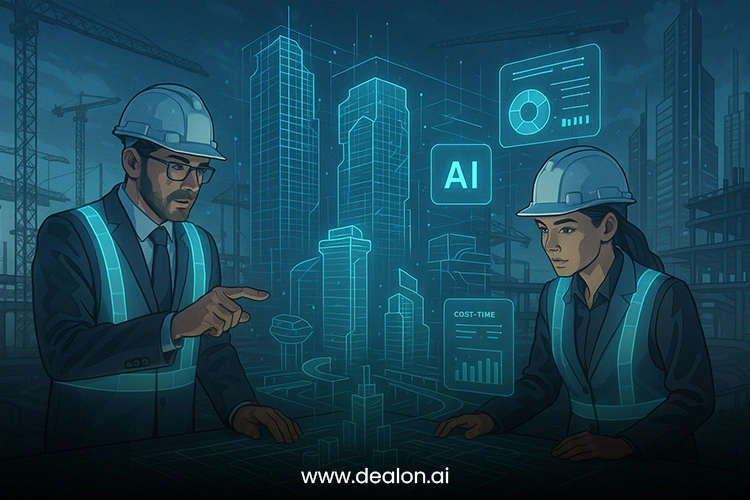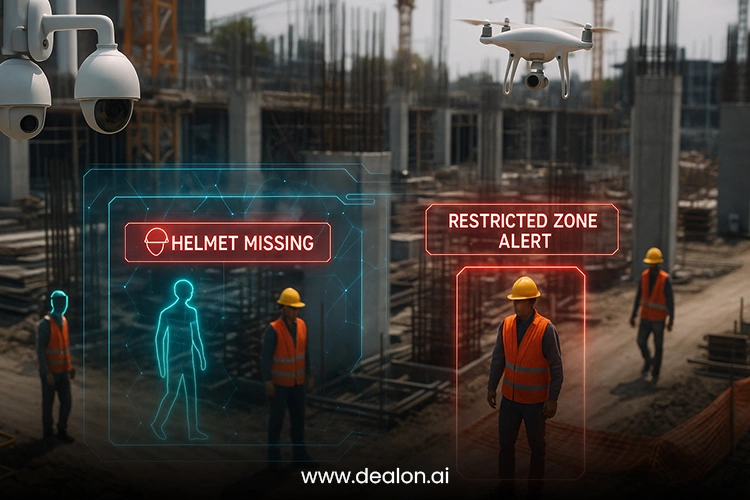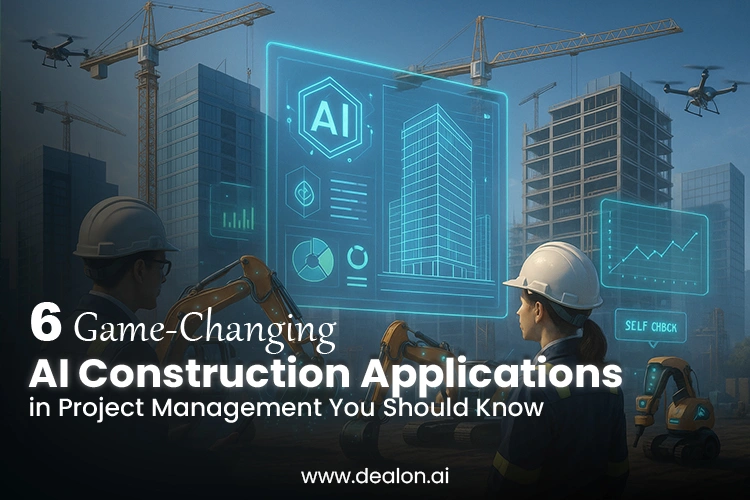The building industry, which has historically been considered one of the most labor- and time-sensitive sectors, is undergoing a radical change of paradigm powered by the combination of Artificial Intelligence (AI). Because technology is constantly changing at an accelerated rate, AI is becoming a game-changer, improving almost every aspect of constructing condominium buildings, including design and planning, execution, and maintenance. The introduction of AI to the construction industry is not merely the process of automating; it is a paradigm change in how projects are conceptualized, run, and executed.
The recent application of AI in construction is on the verge of becoming a revolutionized industry by providing solutions that can significantly enhance efficiency, safety, cost management, and sustainability in the construction industry. The AI can effectively process and evaluate unlimited amounts of data and predict potential dangers as well as workflows to a greater effect, which allows complex projects to be accomplished faster and with more accuracy.
Robotic construction that can be fed by AI is restructuring workforces and can make construction sites more efficient, taking minimal human input. Also, thanks to AI-powered tools, potential equipment failures can be predicted before they take place, significantly decreasing downtimes as well as making sure that maintenance is not performed as a reactionary move, but as a proactive one.
Next to the improvement of operations, AI can provide a solution for sustainable construction. When used to streamline energy consumption rates, minimize wastage, and enhance material use, AI not only assists builders in achieving environmental objectives but also encourages long-term cost reduction. The merger of AI with the construction processes will result in more intelligent, more secure, and more sustainable construction projects, so that the industry is more than capable of countering the ever-increasing needs of an increasingly urbanized world. This post will discuss the six innovative applications of AI in construction that are transforming the construction, management, and maintenance of buildings and infrastructure.
Also Read: 6 AI-Driven Data Revolution in Disaster Response and Recovery
1. AI-based Project Planning and Design

In the conventional scenarios of planning construction projects, human judgment, experience, and knowledge were used long ago in coming up with the design of projects, material choice, the deployment of labor, and planning over the whole course of the projects. Nevertheless, such a practice is full of inefficiencies, mistakes, and a threat to failing to meet the deadlines or to exceed the budget. Artificial Intelligence- a new remedy that empowers the planning process with its capability to study and analyze a large amount of data in real-time.
By analyzing the historical data such as construction schedule, material costs, living material, and labor availability, AI algorithms can be applied to streamline every single element of the planning and design stage. Such tools can present alternative designs, analyze the cost-time-material trade-off, and forecast the effects of various strategies. The AI insights also allow architectural and engineering managers, as well as project managers, to make informed decisions, combined with the reduction of any form of delays or cost overruns, leading to improved efficiency and accuracy.
Among the most potent advantages of AI in construction planning could be considered the capability to model design scenarios. Virtual models Prototyping Virtual models The AI tools can generate virtual models of construction, which enables designers to test different configurations, layouts, and construction methods before making a final design. These simulations also help engineers and architects to predict the possible difficulties, determine and eliminate weaknesses, and maximize designs, making construction much easier.
The virtual-testing phase also offers the advantages of being able to modify such aspects as the materials or even do some minor adjustments to the structure to increase its performance without having to work with physical prototypes, with all their risks and costs. With the use of AI in planning, the construction projects become more accurate, have less waste, and are less cumbersome during the stage of their execution.
The escape of risks that can be predicted and mitigated by AI is also another significant element in the course of planning. The learning models would be able to evaluate the historical project data and draw patterns to anticipate issues in the future, like problems in the supply chain, bad weather, or wait time. With such foresight, the project managers can make alternative plans in advance, hence the chances of delay are narrowed. This foreseeing ability not only enhances the overall project result but also manages the risks and makes the projects more profitable by eliminating the hitches in the execution process at an early stage.
2. Construction Machinery Predictive Maintenance

Predictive maintenance is also one of the most significant AI applications within the construction business. This is because maintenance of the machinery plays a crucial role in construction works being completed on time and on budget. The innovative AI technology represents a change of paradigm regarding equipment management because it provides real-time monitoring and predictive analytics to avoid the surprise failure of equipment and eliminate the need for high-cost repairs.
The conventional maintenance methods are based on periodic examinations and corrective maintenance that may result in lost chances and downtimes. Predictive maintenance, powered by AI, instead operates on the basis of gathering real-time data about the condition of different parts of the construction machinery using sensors embedded in the machinery. These sensors report on such things as engine temperature, fuel consumption, hydraulic pressure, wear-and-tear on the parts, and vibration levels. This information is then fed through AI algorithms to identify and forecast when a machine may go faulty or need repair.
As an example, an AI-driven system can indicate that a piece of equipment is about to reach a critical operational wear point and should be maintained or replaced within a given period. This makes it so that construction firms can perform the repairs during their predetermined downtime when construction plans are not significantly affected. These predictive maintenance tools can also be used to prolong the life cycle of machinery by making interventions before a complete breakdown, which is often costly in repairs, and keep the machinery out of operation long enough.
Other than the elevated equipment uptime, predictive maintenance can also drastically reduce the costs of operating. It enables companies to prevent costly repairs in emergencies by detecting and solving the problems with the equipment prior to causing significant damage and making the machines work efficiently. This will save a lot of money, both in repairs and fuel burn, person-hours, and production. Predictive maintenance can help construction firms improve their overall efficiency, make their maintenance cheaper, and enhance their bottom line by reducing unforeseen downtime and maximizing equipment life span.
3. Robotized Construction Vehicles and Machinery
The introduction of AI into the construction industry is the most radical application of autonomous vehicles and machinery, and their integration at the construction site. It is transforming the construction industry landscape, as autonomous construction equipment promises to increase productivity, safety, and accuracy in the way construction projects are being performed. Artificial intelligence-based robots and vehicles are taking up the work previously done by the human workforce, which in effect includes excavation, transportation of materials, demolition, and even pouring of concrete.
Robots and autonomous machines come with a variety of sensors, cameras, and GPS that enable the autonomous navigation of the construction sites. These robots also apply AI to interpret sensor data and take real-time action; this aspect permits them to perform with keen accuracy and efficiency. Say, autonomous bulldozers or excavators can move earth with impressive precision so that the materials can be moved to the exact places without the participation of humans.
These are some of the main advantages of employing the AI-powered construction site machines, and the most evident one is the enhancement of working safety. A typical construction site is a risky place, as heavy machines and products are used where human beings are severely affected. Using autonomous machines to complete hazardous operations, including demolition or transport of dangerous materials, companies in the construction field will be able to offset the possibility of accidents and injuries considerably. There is also no fatigue in autonomous machinery, cutting down on errors by humans and making the job site safer in general.
Also, the performance of autonomous construction vehicles contributes to shorter project schedules and lower expenses. The machines are able to work twenty-four hours in a row and will never get tired of doing their task, which makes the building faster. Also, construction equipment that is self-governing saves on labor costs in the sense that less manual work is required in some parts of the construction site. During the process, the AI systems have also been utilized to optimize the way of the materials to make sure that the goods are moved around the site as fast and efficiently as possible, increasing the project velocity even more and reducing the chances of delays.
The possibilities of collaboration between autonomous machines and human workers will further develop as the latter become more advanced. A construction machine that is powered by artificial Intelligence can already communicate with other systems on the place, exchange information with project management software, and other machines to ensure smooth coordination. Advances in AI and the evolution of autonomous equipment are likely to reach a point where construction sites will be characterized by more coordinated fleets of autonomous equipment, where AI systems coordinate the movement and behavior of different machines to streamline the whole construction process.
4. Converting Safety and Construction Site Observations-AI Driven

Site nourishment and safety are the key concerns in construction projects; the use of Artificial Intelligence (AI) may change this field and make it a significant revolution in site security. Once characterized by a strict work environment that is physically demanding and risky, the construction industry is currently taking advantage of the applications of AI-based technologies to generate more secure and efficiency-driven work sites. Artificial Intelligence (AI)-based surveillance cameras, sensors, and a sophisticated algorithm are strategically coming to the fore in real-time monitoring of the movements of workers, detecting hazards, and averting accidents.
Unsafe acts and situations that one would fail to notice can be identified using AI systems. As an example, it is possible to mention machine learning and image recognition, which help AI detect a failure to wear protective gear, including harnesses, helmets, or gloves, among others. It is also able to trace whether employees are venturing into restricted or risky areas where heavy movements are going on or there is a possibility of falling, machinery defect, or exposure to harmful substances. AI also automatically marks such unsafe actions to give construction managers real-time alerts to help them address unsafe behaviors before they cause a mistake in order to prevent accidents.
In addition to pinpointing the presence of imminent risks, AI-enabled systems are also able to calculate possible threats relying on previous experiences. Using trends recorded in employee injuries and machinery breakdowns, as well as location-related incidents, AI tools can provide predictive details on the areas of the project that have the highest chances of safety problems. This forecasting ability can ensure that safety actions are taken in advance, hence preventing the rise of mishaps.
Moreover, AI-based safety applications can monitor incidents and record them in real time. This will guarantee that continuous data on the performance of safety is gathered so that when managers evaluate the success of the implemented safety measures, they can make the necessary changes. Such systems not only offer beneficial insights that can be acted upon but also help in ensuring compliance with safety regulations since measures like adequate safety checks and active procedures are taken.
Finally, safety brought about by AI systems not only benefits the well-being of workers but also leads to increased project efficiency. With AI allowing for a decrease in accidents and the likelihood of downtimes due to injury, AI assists in making sure that the project will not experience delays, and eventually, costs could be better managed. When real-time monitoring, predictive analysis, and proactive risk management are combined, they make the workplace safer and more efficient for all the involved parties.
5. Budgeting and Construction Project Management using AI
The construction project management is a complicated and multifaceted procedure involving careful planning, tracking, and the allocation of assets. AI is transforming construction project management because it provides superior analytics, streamlines work processes, and guarantees optimum resource utilization. Since mega construction projects tend to face minimal budgets and timeframes, the utility of AI to foresee, automate, and streamline the diverse facets of project management has assumed an essential role.
Among the key benefits of AI in project management in construction, its capabilities to determine the timeline of the construction project with an outstanding level of accuracy are worth mentioning. AI systems will be able to use historical data to measure the duration of similar tasks, detect bottlenecks, and take into account external circumstances, which can affect the project, like weather conditions, and so on. Such forecasting functions allow project managers to manage their time efficiently so that the projects are on schedule.
The use of AI can go to the management of costs and budgeting. Budgets in construction are easily taken out of hand, thus need to be closely monitored in such a way that unforeseen expenditures do not escalate. AI tools will help keep track of real-time spent on the project, study the changes in prices of materials, and recommend cost-reduction strategies.
Through constantly analyzing these data points, AI will aid in locating areas where resources are underused or overspent, and make suggestions to curb the expenditure to ensure budget overruns do not occur. It also forecasts cost overruns based on the performance of the project with the help of AI techniques and tools, which enable managers to overcome the imminent financial concerns before it can become complicated.
Besides, AI technologies will increase the effectiveness of resource distribution and ensure that working resources and materials are appropriately managed. AI systems make it possible to optimize the time and location of assigning workers to avoid downtimes and inefficiency with the help of superior scheduling and forecasting algorithms. Automation of everyday management duties enables construction managers to concentrate on managerial-level decisions while making sure that the everyday business flows do not get interrupted.
An AI-based project management tool also helps in effective coordination and communication of teams. AI can combine the input of different stakeholders, including the engineers and contractors, into the flow of information and ensure that the information flows. As an example, AI-driven platforms may monitor the progress of any task to be completed, notify the teams of the delays, and propose solutions to the issue in real-time. Such efficient communication makes teamwork, decreases the likelihood of any miscommunication, and prevents possible errors.
6. AI-Based Sustainability and Energy Efficiency
It has been found that sustainability has today become one of the major thrusts in construction, where the sector is striving to minimize its impact on the environment and enact more energy-efficient models. Artificial Intelligence leads these initiatives as it offers new approaches in terms of improving building designs, consuming resources, and treating waste. The contribution of artificial Intelligence to achieving sustainability is not only related to the administration of energy consumption, but it is also about the cultivation of more innovative, greener, and more sustainable building practices.
AI algorithms can scan building designs and ways of construction to identify the chances of energy reduction, minimize waste, and maximize the use of sustainable materials. The algorithms will be able to model the many conditions in the environment, evaluate the flow of energy within a building, and suggest modifications that would improve the overall efficiency of energy. To take an example, AI can simulate the potential of solar energy in the building design and advise the optimal placement of solar panels, or can advise on using heating and cooling systems that are energy efficient by considering the layout of the building and factors of local climate.
Besides the optimization of the energy systems in buildings, AI also contributes significantly to efficiency in construction materials. With AI tools, the usage of materials can be evaluated, and alternatives with a low environmental footprint can be proposed that would not mean a loss of quality or durability. AI enables the construction industry to reduce material waste and offer more sustainable alternative options, which will result in construction projects having a smaller carbon footprint and save money as well.
In the green building design, energy simulations are especially effective since they are operated with AI. With the help of the data about local climate and peculiarities of the building orientation, energy systems, etc., AI will be able to simulate how various energy-saving arrangements will modify the overall efficiency of the building.
These AI tools make new buildings as energy-efficient as possible by identifying the best possible energy-saving solutions before their construction begins. Also, AI will be able to track the energy performance of the entire building in the post-construction stage and inform property management of which systems, such as heating, ventilation, and air conditioning (HVAC), need adjustments to maximize the building’s energy efficiency throughout its lifecycle.
Conclusion
AI is altering the construction industry through optimization of project planning, safety enhancement, and sustainability. AI is transforming the construction process, on both sides of project control: from AI-driven project management tools that have the potential to forecast the schedule and budget to autonomous machines that increase efficiency and safety.
The use of predictive maintenance technologies allows reducing the downtime of any equipment, and AI-driven systems allow providing safer workplace conditions because they can proactively determine the risks. Also, AI helps to encourage sustainable structure and energy efficiency in buildings. Incorporating AI at each level will streamline operations, lower costs, boost the productivity of the companies, and make construction more sustainable; ultimately, the looming future of the industry will prosper in any competitive world.

